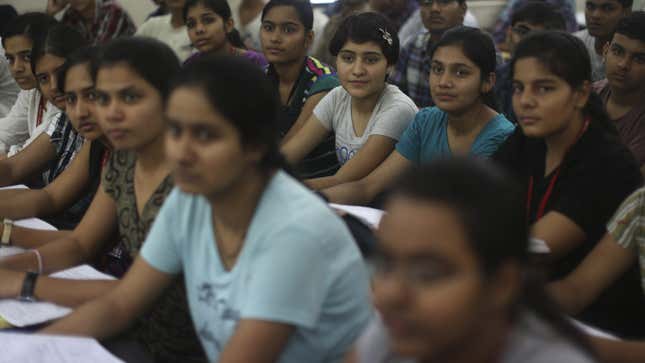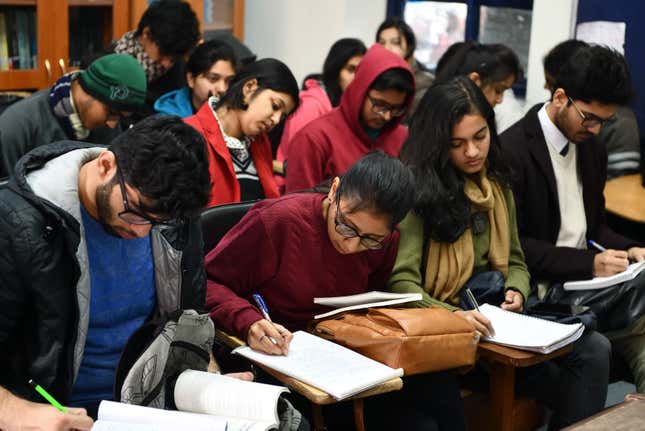“The results are out.”
Every exam season, this phrase can be singularly responsible for hope, despair, dread or celebration among test takers in India. Test taking is serious business, and much like weddings, it is a matter of substantial family pride. A transcript, called a marksheet in India, can determine whether one’s parents will be calling the neighbors to boast about their child’s success, or turning their phones off and avoiding social contact.
The Indian exam system has become a catalyst for social mobility, and—depending on results—the tests can offer the hope of a bright future. This, in turn, ratchets up the tests’ stakes, and demands that India’s educational system be oriented around preparing students for the exams, which in turn sustains an industry of test-coaching centers.
“Whatever exam is high stakes ends up determining the behavior of test takers and those who conduct examinations,” says Pranav Kothari, vice president for large-scale education programs at Educational Initiatives, an Indian company designing new types of tests. “The entire ecosystem is geared towards marks and there is a disease of rote learning.”

In other Asian countries, high-stakes testing is responsible for the misery of millions. In mainland China, for instance, the Gaokao, a grueling nine-hour entrance test for admission to the country’s higher education institutions, has been often called a “pressure cooker” test. Bizarre stories of test takers coming to the exam venue equipped with IV drips have yet not forced the country to rethink its exam system.
South Korea, too, often grapples with high suicide rates among students because of an education system that is geared towards test taking. In Hong Kong, nearly 40,000 parents signed a Facebook petition to scrap the “too difficult” primary school test.

Leading the change
There are few places where the culture of high-stakes testing is as entrenched as it is in India, but small efforts of reform are beginning to surface.
Private startups such as Educational Initiatives are trying to change how schools, parents, and students think about exams. Kothari says most of India’s education policy is currently focused on administrative challenges and school aesthetics. “Our priorities are on mid-day meals, teacher absenteeism, and even whether the school has proper infrastructure. But who pays attention to the quality of testing?” says Kothari.
A December 2017 study attempted just that. The Research on Improving Systems of Education program (RISE) examined (pdf) testing in India, Pakistan, Nigeria, Uganda, and Alberta, Canada. The quality of testing in India and Pakistan was lower than the other countries that were evaluated and was so poor, according to the survey, it promoted a culture of rote learning in these countries.
“In India and Pakistan, higher-order skills were almost entirely lacking and the focus was very much on recall of very specific rote-learnt knowledge (eg, the price a character in one book paid for a carpet, or the specific phrasing of a term in a text book),” Newman Burdett, the study’s author, wrote in the report.
It is this culture EI seeks to change. Through its ASSET test, it aspires to help schools and educational institutions change the way they assess their students’ capabilities by asking questions that need analysis rather than memorization. Nearly 400,000 students in 3,000 private Indian schools take the ASSET test annually, according to EI. But because it doesn’t replace the compulsory government exams every Indian high school student takes after the 10th and 12 grade, Kothari concedes it has less relevance for older students.
“We found questions in standardized tests that asked random information like the weight of the pituitary gland, or those about India’s exports. How can children respond accurately when the figure is so transient?” Kothari explains. “In fact, even the teacher eligibility test is very bad. Some of the best teachers have not been able to clear it because it tests memory over talent.”
Schools are geared toward this kind of learning because the entrance exams for leading universities in India focus heavily on testing knowledge rather than skills. This is also why there is a resistance to changing the system.
“There are certainly people working towards changing this ecosystem, but awareness among common people is still only theoretical. Ask people on the road about whether tests are getting too hard to crack, and if coaching centers are good, they will universally agree that a change is needed,” says Arghya Banerjee, founder of the Levelfield School, a private school that focuses on skills-based learning, in rural West Bengal. “But those are the very people who would send their children to coaching centers.”
India’s collective unwillingness to grapple with its testing culture is to the benefit of the test-prep industry. According to a report in the Mint newspaper, the private coaching center industry in India was estimated to be Rs49,500 crore ($7 billion) annually. The industry in India grew in double digits over the past five or six years, second only to the robust test prep industry in South Korea.
A few small towns in India are oriented around such coaching centers, where students from far-flung regions come to prepare for entrance exams like the JEE—the joint entrance exam for the 23 campuses of the Indian Institute of Technology—and the National Entrance cum Eligibility Test (NEET) for entrance to medical colleges. Kota, a small town in the Indian state of Rajasthan, is infamous for these coaching centers, and parents and students often take up rented accommodations and change schools to attend them. Kota is also notorious for student suicides. In the truest sense, the IIT entrance exam is alarmingly high-stakes.

The mindset problem
Banerjee, a former finance executive, left the corporate world to found Levelfield in 2009 out of frustration with the reliance on rote learning and test taking he found while looking for a school for his daughter. The school’s website delivers lengthy manifestos against rote learning and for a more holistic education that embraces ethics and critical thinking to prepare students for a complex world.
“Testing has become high stakes because of the unthinking craze for certain careers, which most people believe will pay rich dividends. Unfortunately, this is not true. This unidimensional education no longer pays off,” says Banerjee.
Other experts agree. “In the past 25 years, the quality and policy reforms in Indian higher education have not kept pace with the changes in the society and the economy. As a result, many families and students face limited options for socioeconomic mobility,” says Rahul Choudaha, US-based international education analyst and blogger at DrEducation.
For decades, as India industrialized, there was a huge emphasis on engineering degrees, and preparing for students for the exams required to earn them. Students are still steered toward engineering, even if the economy has moved on, says Banerjee.
“These exams are sort of relics of the past,” he says. “Today, engineers often go into the software field, or even do MBAs. All they need is to learn a coding language, and for that they don’t need to sit for the JEE.”
But even the institution-specific MBA entrance tests in India are heavily dependent on assessing talent through quantitative questions, which, in turn, engineering students can easily crack. That means management school are filled with such students and a favorite question business professors ask on the first day is “how many of you are engineers?”
This engineering-heavy imbalance in classrooms plagues business schools, because they produce graduates who are often unable to think out of the box. The Common Admission Test, used by the 20 elite Indian Institute of Management campuses, also relies heavily on quantitative skills. And an abundance of entrance test coaching centers ensure that an increasing number of aspirants sit for the test every year. For the upcoming 2019 CAT, 244,000 people have registered, up by 3,000 from last year. For 2018, 241,000 test takers applied for 12,411 seats at the country’s IIMs, a ratio of nearly 20 applicants for each seat.
Some elite institutes today are trying to minimize the role of standardized tests in admissions, or to offer applicants more flexibility in how or when they take exams. The Indian School of Business (ISB)— a private management school founded in 2001 in association with Wharton and Kellogg schools in the US— accepts the GMAT, for instance, an international exam offered multiple times a year that gives a broader view of the test taker’s abilities.
ISB also relies heavily on the overall profile—work experience, education, social service—to pick applicants for a more diverse classroom. “We look for people with backgrounds in areas like the arts, and athletics, etc. We don’t want everybody to be an engineer,” says Philip Charles Zerrillo, deputy dean at ISB. “India hands out a lot of engineering degrees because they transport well. But a degree like law is heavily dependent on context—geographical, social—and so it forces the student to open his or her mind up. That also brings diversity to the classroom.”
ISB, though, is only among a handful of institutions using different tactics for assessing Indian students. The largest proportion of colleges and institutions still rely heavily on standardized tests with poor quality questions. As long as these tests don’t change, the problem of rote learning persists, too.


Policy push
In June, India’s government proposed overhauling its higher education system with a New Education Policy designed to boost the total number of students in colleges and universities. In its draft, the government also wants to eliminate the 10+2 format of school education, where one exam in the 10th grade and another in the 12th define a student’s performance throughout his or her school life. Instead, it would be replaced with a 5+3+3+4 format, with more opportunities to assess students throughout their education. This was proposed as a means to reduce exam time stress and take away the momentousness of the 10+2 exams.
Other nations have managed to diminish the role of standardized testing, or discard it altogether. Students in Finland, long the model of a successful national education system, take just one national test and only if they are moving on to university. Instead, the country relies on formative assessment—measuring students as they learn, not after, and providing constant feedback and coaching.
In countries that embraced testing regimes, momentum has shifted and educators are now rethinking their value. Australia, which adopted the National Assessment Plan—Literacy and Numeracy (NAPLAN) in 2008, is now considering its unintended consequences, such as a narrowing curriculum, anxious students, and the birth of a coaching industry. Three Australian states are conducting a review of NAPLAN and its future, with one stated goal determining “the impact of the assessment on schools, students and the community.”
Singapore has also faced a severe backlash from students and parents for this year’s primary school leaving exam (PSLE), which left pupils in tears because it was exceptionally difficult. The island nation is rethinking its reliance on testing and while major reforms may not be in the near future, Singapore has decided to modify the PSLE from a points-based system to a band-based one from 2021, so students don’t labour over small improvements in their test scores.
In the US, there’s a growing awareness that standardized tests, intended to be meritocratic, give an unfair advantage to families with the resources and ability to navigate bureaucracies and access tutoring. In New York City, the Specialized High School Admissions Test, which determines who attends the city’s selective public schools, has come under fire for perpetuating racial imbalances. At Stuyvesant High School, for example, only seven out of 895 students were African-American, and the state legislature has taken up the issue.

Kothari believes that unless Indian attitudes towards testing significantly changes, changing the school format is only window dressing. “Board examination results are often a political issue as well, because they show if the ruling party is doing well in the state or not. This means, the pass percentage for every year has to be kept high at all costs,” he says.
Examiners resort to grace marks, giving additional marks to a student just so she or he could pass an exam, making tests easier and even more memory-based to keep these numbers up. A press release following a recent national high school exam announced the pass percentage increased by 0.39%—a minute improvement considered important enough to be highlighted as an achievement on the government’s part.
The key to change, Kothari says, is gradual reform. “Big and sexy reforms are a recipe for inaction,” he says. “You can’t turn switches. We need to give people notice, change the proportion of high-quality questions, which will massively change how we learn and teach.”
This is particularly crucial as India readies to participate in the next Program for International Students Assessment (PISA), the international benchmarking exercise conducted by the Organization for Economic Cooperation and Development in 2021. Indian students last took the PISA in 2009, where the country ranked 72nd among the 74 nations that participated. It is probably too late for India to change course in time for 2021, but if it wants to dramatically improve that score in future PISAs, it needs to make its tests and its education system more skills based.
For now, though, the mantle of reform is held by a clutch of elite, private institutions, even if eventually their students have to take the same government-regulated, standardized test as the rest of India. “There is always going to be a test at the end of class 12. But do you want that exam to be knowledge oriented, that you forget after the exam? Or do you want it to be skill oriented? That’s what we need to address,” says Banerjee.




